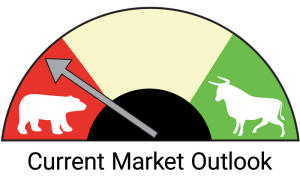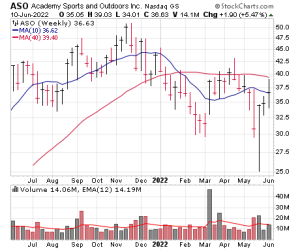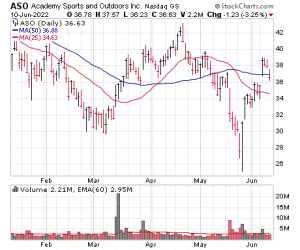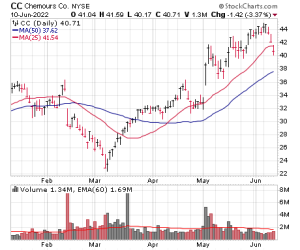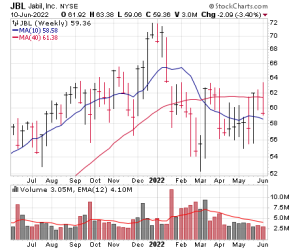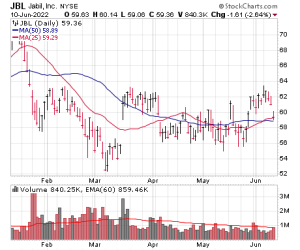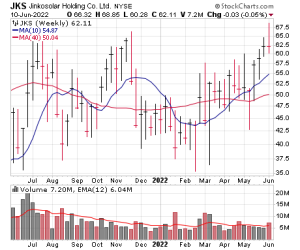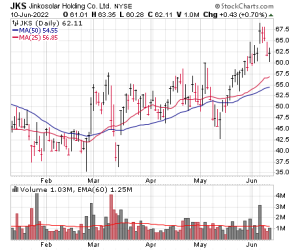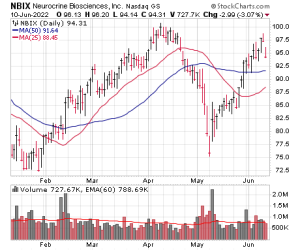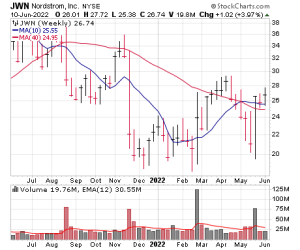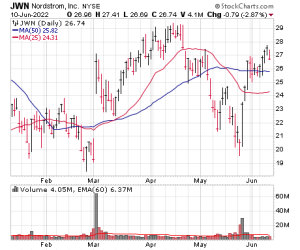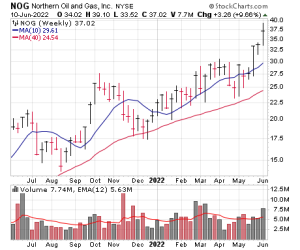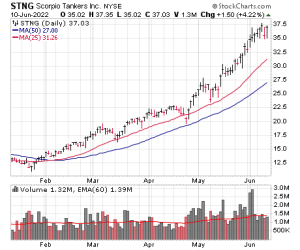The market did a decent job during the prior three weeks of getting in position to flash an intermediate-term green light, but it was a case of close but no cigar, and now the sellers are back at it, with stocks essentially having a mini-crash since last Thursday. It’s vital to remain focused on the evidence, which obviously remains negative, and to honor your stops for things that are falling out of bed. Looking ahead, there’s certainly enough panic and some positives in the broad market to put in a low, but of course we have to see the buyers step up and take control before putting much capital in harm’s way.
This week’s list has a collection of decent-looking stocks—nothing is really great here, but these names are either in overall uptrends or have shown recent buying power. Our Top Pick is from the latter camp, with shares miles above their prior low and recently reacted well to earnings.
Cabot Top Ten Trader Issue: June 13, 2022
DOWNLOAD ISSUE PDFBears Strike Back
The market did a decent job during the prior three weeks of getting in position to flash an intermediate-term green light, but it was a case of close but no cigar—the trend never quite turned up, stocks that approached resistance couldn’t quite break out and the broad market couldn’t quite develop enough strength to be considered healthy. And now the sellers are back at it, with stocks essentially having a mini-crash since last Thursday and collapsing today on fears the Fed will really choke off the money spigot. We do advise tuning out the noise and predictions (both bullish and bearish); instead, it’s vital to remain focused on the evidence, which obviously remains negative, and to honor your stops for things that are falling out of bed. Looking ahead, we’re just taking it day to day—there’s certainly enough panic and some positives in the broad market (fewer stocks hitting new lows than in early May) to put in a low, but of course we have to see the buyers step up and take control before putting much capital in harm’s way. Our Market Monitor is back down to a level 2.
This week’s list has a collection of decent-looking stocks—nothing is really great here, but these names are either in overall uptrends or have shown recent buying power. Our Top Pick is Academy Sports & Outdoors (ASO), which has a bargain valuation, is miles above its May low and recently reacted well to earnings.
| Stock Name | Price | Buy Range | Loss Limit |
| Academy Sports & Outdoors (ASO) ★ TOP PICK ★ | 33 | 32-34 | 28-29 |
| Arch Coal (ARCH) | 156 | 163-167 | 145-147 |
| Chemours (CC) | 38 | 37-39 | 34-35 |
| Coterra Energy (CTRA) | 32 | 31.5-33 | 27.5-28.5 |
| Jabil (JBL) | 56 | 55.5-57 | 50.5-51.5 |
| Jinkosolar (JKS) | 58 | 56-58.5 | 49-51 |
| Neurocrine Biosciences (NBIX) | 91 | 89-92 | 81-82.5 |
| Nordstrom’s (JWN) | 25 | 23.5-25 | 20-21 |
| Northern Oil & Gas (NOG) | 35 | 32-34 | 28-29 |
| Scorpio Tankers (STNG) | 34 | 31-33 | 26.5-27.5 |
Stock 1
Academy Sports & Outdoors (ASO) ★ Top Pick
| Price | Buy Range | Loss Limit |
| 33 | 32-34 | 28-29 |
Why the Strength
Despite a turbulent economic backdrop, Academy Sports has become a standout among sporting goods retailers. The company operates a chain of 260 retail outlets across 16 Southeastern states, with its biggest presence in Texas (with 108 stores). Nearly all of its locations that have been in operation for over four years have been consistently profitable in the face of an uncertain macro environment, thanks in part to what Academy sees as a consumer trend to enjoy a “healthier, happier, and more fun lifestyle,” a trend that accelerated during the pandemic but has remained surprisingly robust in recent quarters, too. What’s more, Academy just opened its first new location since 2019 (in Atlanta), and management has been pleased with the store’s performance to date, with expectations that EBITDA will be positive after the first year of operation. Additionally, Academy plans to open at least eight new stores this year as part of a bigger plan to open 80 to 100 stores over the next five years, so there’s a cookie-cutter story here as well. Most important, results remain buoyant: In Q1, although revenue of around $1.5 billion was 7% lower from a year ago (partly due to its comparison with stimulus-driven 39% comp sales in the prior year’s quarter), it still exceeded estimates by 16%. When compared with pre-pandemic Q1 2019, moreover, sales grew each division by at least 20% (with outdoors increasing more than 50%!). E-commerce sales jumped 19% while per-share earnings $1.73 beat the consensus by 32 cents. Looking ahead, analysts do see a slight dip in earnings this year, but the real story is that the drop isn’t going to be large—earnings should remain north of $7 per share this year (P/E near 5!) and grow as more stores open in 2023.
Technical Analysis
After peaking last November around 50, ASO rode the retail sector decline over the three-and-a-half months that followed, bottoming at 30 in early March. A relief rally then kicked off which took the stock up to 42 by mid-April, but that’s when the market’s next leg down began, pulling ASO as low as 25—but that was likely the bottom. Shares have since catapulted higher, first on the retail rebound and then on earnings last week. The pullback of the past couple of days has been sharp but on reasonable volume and hasn’t taken back much of the May/June rebound. We’re OK starting a position here if you want in.
| Market Cap | $3.12B | EPS $ Annual (Jan) | |
| Forward P/E | 5 | FY 2021 | 4.16 |
| Current P/E | 5 | FY 2022 | 7.60 |
| Annual Revenue | $6.67B | FY 2023e | 7.05 |
| Profit Margin | 8.0% | FY 2024e | 7.65 |
| Qtrly Rev | Qtrly Rev Growth | Qtrly EPS | Qtrly EPS Growth | |
| ($M) | (vs. yr-ago-qtr) | ($) | (vs.yr-ago-qtr) | |
| Latest qtr | 1.47 | -7% | 1.73 | -8% |
| One qtr ago | 1.81 | 13% | 1.61 | 48% |
| Two qtrs ago | 1.59 | 18% | 1.75 | 61% |
| Three qtrs ago | 1.79 | 12% | 2.34 | 19% |
Weekly Chart | Daily Chart |
Stock 2
Arch Coal (ARCH)
| Price | Buy Range | Loss Limit |
| 156 | 163-167 | 145-147 |
Why the Strength
It was about a year ago when we first dug into many energy stocks, and when running the numbers on their potential cash flows, led to some jaws hitting our office desks. It’s a similar story today with many coal stocks, which are benefitting from elevated prices to such an extent that the cash flow numbers (in relation to the market caps) are almost hard to believe. Arch Resources is one of the leaders in the group, with the main attraction its met coal (used to make steel) operations in West Virginia, which are both low cost and produce higher-grade met coal that often fetches premium prices (it has a 30% global share of this type of higher-end coal). While that business generates 80% of cash flow, Arch also has some solid thermal coal mines in Colorado and the Powder River Basin; at this point the firm is basically milking those, putting in little money (it’s only spent $110 million on those operations since 2017!) and harvesting whatever cash flow comes. In fact, Arch has already locked in high prices for its thermal segment through 2023 and even some beyond that. As you can see in the table below, the results have been ridiculous of late, which has allowed the company to get to a positive net debt position (it recently bought back $125 million of convertible debt), and thus, is aiming to return half of free cash flow to shareholders with the other half being used for buybacks, special payouts and more debt reduction. The result: For Q1, Arch paid a dividend totaling $8.11 per share (!), and that figure should improve going forward as the quarter was affected by inadequate rail capacity shipments. Now, of course, the risk here is the economy—if the Fed (and other central banks) go bananas, demand and pricing could easily slip for met coal, but given all the supply issues in the world, it’s unlikely a collapse is coming any time soon. Wall Street sees out-of-the-world earnings this year and, even with a huge drop, a massive tally in 2023.
Technical Analysis
ARCH and most coal stocks have all had huge runs, so it’s possible the rug could get pulled out from under them; today, of course, wasn’t a good day. But, really, the group and ARCH continue to act as well as can be—the stock has etched something of a base-on-base, with the massive-volume buying support after Q1 earnings in April offering shares support. We’re going to set our buy range up a bit, thinking a rally back after today’s dip could provide an entry point.
| Market Cap | $2.60B | EPS $ Annual (Dec) | |
| Forward P/E | 2 | FY 2020 | -22.74 |
| Current P/E | 5 | FY 2021 | 19.20 |
| Annual Revenue | $2.72B | FY 2022e | 71.11 |
| Profit Margin | 31.3% | FY 2023e | 34.91 |
| Qtrly Rev | Qtrly Rev Growth | Qtrly EPS | Qtrly EPS Growth | |
| ($M) | (vs. yr-ago-qtr) | ($) | (vs.yr-ago-qtr) | |
| Latest qtr | 868 | 143% | 12.89 | N/A |
| One qtr ago | 806 | 123% | 11.92 | N/A |
| Two qtrs ago | 594 | 55% | 4.92 | N/A |
| Three qtrs ago | 450 | 41% | 1.66 | N/A |
Weekly Chart | Daily Chart |
Stock 3
Chemours (CC)
| Price | Buy Range | Loss Limit |
| 32 | 37-39 | 34-35 |
Why the Strength
DuPont spin-off Chemours (covered in the May 9 report) is a big player in the chemical industry, specializing in titanium technologies and fluoropolymers, but also providing ingredients used for plastics, coatings and oil refining, as well running mineral sands mining operations. The Q1 report was the main source of the stock’s strength, as Chemours reported eye-opening improvements in total volume growth and pricing that drove sales and per-share earnings increases of 22% and 105%, respectively. But the latest show of strength was driven by a couple of additional factors, including the company’s exposure to the red-hot oil and gas industry. Indeed, Chemours has ridden the broad energy sector rally of late thanks to its leading position as a provider of glycolic acid, a chemical that enhances the cleaning and descaling processes in oil field and petroleum refining applications (as well as being used in the industrial cleaning and electronics industries). Additionally, Chemours’ advanced performance materials business, which includes materials critical for smart devices and clean energy (EVs and hydrogen), is expected to be a major revenue driver going forward and is a big part of the firm’s longer-term growth strategy. On that score, Chemours just announced that it’s looking into investments to increase its hydrogen economy-related business to support demand for water electrolysis and fuel cell technology. (The firm is considering potential locations in the U.S. and Europe, with an emphasis on shifting its portfolio to sustainable offerings.) After a huge earnings leap last year, Wall Street sees another big (32%) hike in 2022 and double-digit growth after that, too. A solid yield (2.5%) and modest P/E (8x this year’s earnings estimates) also helps the cause.
Technical Analysis
CC hit a peak around 39 last June and had some big downs and a couple of solid rallies in the months that followed, but net-net, the stock went nowhere for 11 months. Shares began to change character in March, with two massive-volume buying weeks off the bottom, and that was followed by a big breakout on earnings in early May. After running to 45, CC has been yanked back down by the market, but on reasonable volume, and the stock is now testing its 50-day line. If you want to take a swing at it, CC looks like a decent risk-reward around here.
| Market Cap | $6.33B | EPS $ Annual (Dec) | |
| Forward P/E | 8 | FY 2020 | 1.98 |
| Current P/E | 9 | FY 2021 | 4.00 |
| Annual Revenue | $6.68B | FY 2022e | 5.26 |
| Profit Margin | 12.4% | FY 2023e | 6.00 |
| Qtrly Rev | Qtrly Rev Growth | Qtrly EPS | Qtrly EPS Growth | |
| ($M) | (vs. yr-ago-qtr) | ($) | (vs.yr-ago-qtr) | |
| Latest qtr | 1.76 | 23% | 1.46 | 106% |
| One qtr ago | 1.58 | 18% | 0.81 | 33% |
| Two qtrs ago | 1.68 | 36% | 1.27 | 170% |
| Three qtrs ago | 1.66 | 51% | 1.20 | 567% |
Weekly Chart | Daily Chart |
Stock 4
Coterra Energy (CTRA)
| Price | Buy Range | Loss Limit |
| 32 | 31.5-33 | 27.5-28.5 |
Why the Strength
Coterra Energy reminds us a bit of a bigger Civitas Resources in the sense that both are “new” names to most investors, simply because they were formed from some M&A activity in recent quarters—in Coterra’s case, it’s the result of a combination of Cabot Oil & Gas (no relation to us) and Cimarex Energy, with the end result being a well-balanced firm with exposure to oil and gas (54% of revenues are gas, 34% oil and 12% liquids) in the two premier basins in the country, the Marcellus (177,000 net acres) and the Permian (234,000 acres)—combined these two areas take up north of 90% of the drilling and completion budget—with a decent position in the gas-heavy Anadarko as well. And the firm has followed that balancing act with its hedge program (25% of remaining 2022 volumes hedged; target 20% to 30%), enough to protect downside but leave room for upside, while the balance sheet has no maturities until 2024 and has net debt less than 0.5x cash flow. (The firm’s free cash flow breakeven is less than $40 oil and about $2.25 natural gas!) And all of that means Coterra is returning massive amounts of cash to shareholders: In Q1, free cash flow totaled about $1.20 per share, leading to 60 cents in total dividends and it bought back nearly 1% of all shares outstanding, too. As of early May, the firm said strip pricing would result in a ridiculous $4.5 billion of free cash flow in 2022 (~$5.50 per share), but at that time oil and gas prices were about 10% or so below current levels. Thus, even if we do see a pullback in energy prices (which, to be fair, is certainly possible), dividends totaling a 7% to 8% yield, plus share buybacks and further debt reduction are on the way—and we like the fact that if, say, oil pulls in but gas stays strong, Coterra should still benefit. It’s a good (and probably under-followed) story.
Technical Analysis
It hasn’t been a smooth ride, but CTRA changed character in late January, embarking on a two-steps-forward, one-step-back type of uptrend, with every dip finding support at or just above the rising 50-day line, and with the recent pullback following the script. Today’s drop wasn’t pleasant, but CTRA remains north of its key trend line and none of the action looks abnormal to this point; you could nibble here with a stop in the upper 20s.
| Market Cap | $27.7B | EPS $ Annual (Dec) | |
| Forward P/E | 7 | FY 2020 | 0.54 |
| Current P/E | 13 | FY 2021 | 2.25 |
| Annual Revenue | $4.67B | FY 2022e | 4.59 |
| Profit Margin | 47.0% | FY 2023e | 3.77 |
| Qtrly Rev | Qtrly Rev Growth | Qtrly EPS | Qtrly EPS Growth | |
| ($M) | (vs. yr-ago-qtr) | ($) | (vs.yr-ago-qtr) | |
| Latest qtr | 1679 | 265% | 1.01 | 173% |
| One qtr ago | 2225 | 387% | 0.83 | 219% |
| Two qtrs ago | 440 | 51% | 0.52 | 478% |
| Three qtrs ago | 325 | -2% | 0.26 | 420% |
Weekly Chart | Daily Chart |
Stock 5
Jabil (JBL)
| Price | Buy Range | Loss Limit |
| 56 | 55.5-57 | 50.5-51.5 |
Why the Strength
Jabil is a global contract manufacturing solutions provider that makes a wide variety of products and offers electronics design engineering, packaging and consulting services for clients across several major industries, including healthcare, automotive and semiconductors. As such, it plays a major role in easing the ongoing global supply-chain crunch for some of the world’s biggest brands. In fiscal Q2, Jabil reported consensus-beating revenue of $7.5 billion that was 11% higher than a year ago, while per-share earnings of $1.68 beat expectations and were up 32%. The strong results were led by 4% revenue growth in Jabil’s Diversified Manufacturing Services segment and a 19% jump in Electronics Manufacturing Services. Leading the former segment for Jabil is the company’s relationship with Apple—its largest customer—for whom it makes the casings for Apple’s iPhones and iPads (Apple provided 22% of Jabil’s 2021 sales). With analysts expecting iPhone sales to increase this year, the firm’s relationship with Apple should keep Jabil’s top line strong. Management, meanwhile, has expressed a commitment to generating in excess of $700 million in free cash flow for this year (at least $5 per share) along with expanding margins. For the fiscal third quarter, the company sees revenue coming in at a midpoint of $8.2 billion (up 14% from a year ago and 9% higher sequentially if realized), while EPS is expected to come in around $1.60 (up 23%); both predictions are in-line with Wall Street’s estimates but could prove conservative given Jabil’s exposure to fast-growing spaces like cloud computing, EVs and clean energy (to name just a few). The next update comes on Thursday morning, when Q3 results will be released.
Technical Analysis
JBL broke out of a big-picture base in March 2021 and stair-stepped its way higher for the rest of the year, rising as high as 72 before the market got its claws into it. The stock pulled back to 52 by March and found solid support on earnings … and, interestingly, JBL has held those lows ever since, despite the market environment. Of course, like most everything, the chart isn’t great, but it’s an interesting setup into this week’s earnings—if you’re (very) aggressive, you could nibble in this area of support, or just wait to see if earnings can bring in the buyers (a gap above 63 after the report would be very encouraging).
| Market Cap | $8.38B | EPS $ Annual (Aug) | |
| Forward P/E | 8 | FY 2020 | 2.90 |
| Current P/E | 10 | FY 2021 | 5.61 |
| Annual Revenue | $30.7B | FY 2022e | 7.23 |
| Profit Margin | 3.3% | FY 2023e | 7.67 |
| Qtrly Rev | Qtrly Rev Growth | Qtrly EPS | Qtrly EPS Growth | |
| ($M) | (vs. yr-ago-qtr) | ($) | (vs.yr-ago-qtr) | |
| Latest qtr | 7.55 | 11% | 1.68 | 32% |
| One qtr ago | 8.57 | 9% | 1.92 | 20% |
| Two qtrs ago | 7.41 | 1% | 1.44 | 47% |
| Three qtrs ago | 7.21 | 14% | 1.30 | 251% |
Weekly Chart | Daily Chart |
Stock 6
Jinkosolar (JKS)
| Price | Buy Range | Loss Limit |
| 58 | 56-58.5 | 49-51 |
Why the Strength
Recent decisions by the E.U. and the U.S. to suspend tariffs for solar imports and cut red tape for solar installations have given the sector a shot in the arm while providing the industry with a reason to cheer. The market for solar panels has grown at an annual rate of 33% in the U.S. alone in the last decade, and experts believe the growth will continue between now and 2030. This puts China-based JinkoSolar, which offers solar cells, wafers and complete modules, in an enviable position. Jinko shipped some 11 gigawatts (GW) of modules as of 2020, putting it in the top five of global market share and a number one rank in photovoltaic (PV) panel production. What separates Jinko from its competitors is its solar cell enhancement technology, led by its top-selling Jinko Solar Eagle G4 panels (its most efficient), which are based on Passivated Emitter and Rear Contact technology that creates more energy than conventional cells. Jinko is also addressing the problem of storing energy on days when the sun isn’t shining, recently partnering with a top German solar energy firm to install storage systems across Europe through late 2023 (a reason for the strength). Booming demand for Jinko’s wares was evident in the first quarter, with module shipments increasing 76% from a year ago, while total shipments rose 57%. And though per-share earnings of 10 cents missed estimates, Q1 revenue grew by an eye-popping 86%. For Q2, Jinko expects total shipments of around 9 GW—nearly double the year-ago rate. Analysts see sales nearly doubling in the next two quarters, due partly to soaring oil prices that make solar more competitive with traditional power generation; earnings should ramp significantly in the quarters to come.
Technical Analysis
JKS has spent the better part of the past two years in a wide, sloppy trading range, though that’s actually better than many solar peers (and hugely better than most Chinese-related stocks). The stock made the cut today because of its recent action—the low of the year came in February near 35, with two higher lows after that in March and May, and it enjoyed a great run to the upper 60s last week before the market yanked it down. There should be solid support in the mid to upper 50s, so you can consider entering here or on weakness if you want to roll the dice.
| Market Cap | $2.96B | EPS $ Annual (Dec) | |
| Forward P/E | 18 | FY 2020 | 3.02 |
| Current P/E | 36 | FY 2021 | 1.76 |
| Annual Revenue | $7.47B | FY 2022e | 3.38 |
| Profit Margin | 1.3% | FY 2023e | 5.17 |
| Qtrly Rev | Qtrly Rev Growth | Qtrly EPS | Qtrly EPS Growth | |
| ($M) | (vs. yr-ago-qtr) | ($) | (vs.yr-ago-qtr) | |
| Latest qtr | 2.33 | 92% | 0.09 | -40% |
| One qtr ago | 2.58 | 79% | 0.67 | 509% |
| Two qtrs ago | 1.33 | 3% | 0.05 | -95% |
| Three qtrs ago | 1.23 | 3% | 0.89 | -26% |
Weekly Chart | Daily Chart |
Stock 7
Neurocrine Biosciences (NBIX)
| Price | Buy Range | Loss Limit |
| 91 | 82-92 | 81-82.5 |
Why the Strength
Tardive Dyskinesia (TD) is a side effect caused by neuroleptic drugs treating psychotic or gastrointestinal conditions. People suffering from it have involuntary movements, such as grimacing, eye blinking, sticking out their tongue and sucking in their cheeks. Neurocrine Biosciences has an FDA ‘breakthrough’ drug called Ingrezza (the actual active drug is named valbenazine) that treats the condition. Launched five years ago, Ingrezza tallied more than $1 billion in sales last year, and it’s off to a stronger start in 2022, up 30% to $303 million Q1 sales, despite normal lags in prescription renewals that begin each year. TD was first recognized in the 1960s, but there remains a lot of education to be done – management says most TD patients hadn’t even heard of their condition five years ago. Estimates are that 500,000 people remain undiagnosed or untreated with TD in the U.S., five times the number of people using Ingrezza now. The drug should see tailwinds as office visits return to normal as the virus’ effects fade – very few scripts are written for Ingrezza outside of in-person visits. Japan has also recently approved valbenazine for TD there, to be sold under the brand Dysval. Right now, Neurocrine Biosciences is almost all Ingrezza, with its second approved drug, Ongentys, for the treatment of Parkinson’s Disease, just reaching market in September. Phase III studies are underway for using valbenazine to treat Chorea in Huntington Disease, as a schizophrenia therapy and for dyskinetic cererbal palsy. Also in Phase III is a new treatment, crinecorfont, to address adrenal hyperplasia; top-line data is expected in 2023 for that. After a tough 2021, expect revenues to rise about 20% this year, with earnings up a similar amount, and 2023 should see the bottom line boom.
Technical Analysis
Like so many biotech names, NBIX has been out of favor for a while, peaking back in the summer of 2020 and bouncing down its chart over the past couple of years. Recently, the stock did get hit in May when the company missed earnings for Q1 (adjusted EPS of $0.30 compared to $0.59 consensus), a result of seasonal costs and ramping up the Ingrezza sales force to 250 people. However, the low of 75 was north of the January nadir (72), and NBIX quickly made up ground, nearly getting to the century mark before backing off. If you want in, we’re not opposed to starting a position here or on further weakness.
| Market Cap | $9.01B | EPS $ Annual (Dec) | |
| Forward P/E | 44 | FY 2020 | 2.95 |
| Current P/E | 60 | FY 2021 | 1.81 |
| Annual Revenue | $1.21B | FY 2022e | 2.13 |
| Profit Margin | 9.6% | FY 2023e | 3.23 |
| Qtrly Rev | Qtrly Rev Growth | Qtrly EPS | Qtrly EPS Growth | |
| ($M) | (vs. yr-ago-qtr) | ($) | (vs.yr-ago-qtr) | |
| Latest qtr | 311 | 71% | 0.30 | -40% |
| One qtr ago | 312 | 86% | 0.04 | -96% |
| Two qtrs ago | 296 | 46% | 0.64 | N/A |
| Three qtrs ago | 289 | 89% | 0.63 | -56% |
Weekly Chart | Daily Chart |
Stock 8
Nordstrom’s (JWN)
| Price | Buy Range | Loss Limit |
| 25 | 23.5-25 | 20-21 |
Why the Strength
Nordstrom’s 100 high-end namesake department stores and its 250 discount Nordstrom Rack locations are seeing benefits from the consumer shift away from a couple years worth of pandemic behavior. In particular, Nordstrom stores are seeing customers refreshing their wardrobes and buying designer brand outfits for specific occasions. Nordstrom’s average customer is wealthier than other retailers’, so the company didn’t see any lift from stimulus checks, but this year, those same customers are spending more despite the iffy economy and inflation, which is also a credit to Nordstrom’s reputation for trendy designer items and excellent customer service. Meanwhile, its Rack stores are seeing better inventories after being caught too-light during the supply chain disruption of the pandemic. Nordstrom management sees Rack as the entry point for new customers to grow into its high-end department store offerings, with its advantage being brands that avoid discount retailers will sell through Rack because of Rack’s ability to avoid reliance on sales promotions. Management credits its use of AI in allowing the firm’s buyers to be more successful getting what customers want for an upcoming season. One pandemic hold-over – a bigger shift to shopping online – should allow the company to grow while modestly shrinking the overall store count each year. Two new strategies should also help. Stores will start featuring more activewear, anchored by mini-stores for Tonal, a pricey wall mounted workout system. Nordstrom also is expanding private label offerings, which provide better margins. After posting a large pandemic-driven loss in 2021, Nordstrom should swing to a profitability again this year, with earnings likely coming in north of $3 per share.
Technical Analysis
JWN collapsed late last year when the market first went over the falls, but after hitting a low near 19 in December, it’s effectively stopped going down—a big earnings gap in March helped, and the recent retest in May was again halted by a bullish earnings reaction, with JWN surging back above all its key moving averages. Like everything else, the stock got hit today, but it certainly seems like the low 20s should be solid support.
| Market Cap | $4.29B | EPS $ Annual (Jan) | |
| Forward P/E | 9 | FY 2021 | -3.32 |
| Current P/E | 13 | FY 2022 | 1.49 |
| Annual Revenue | $15.4B | FY 2023e | 3.12 |
| Profit Margin | 4.5% | FY 2024e | 3.19 |
| Qtrly Rev | Qtrly Rev Growth | Qtrly EPS | Qtrly EPS Growth | |
| ($M) | (vs. yr-ago-qtr) | ($) | (vs.yr-ago-qtr) | |
| Latest qtr | 3.57 | 19% | -0.06 | N/A |
| One qtr ago | 4.49 | 23% | 1.23 | 486% |
| Two qtrs ago | 3.64 | 18% | 0.39 | 86% |
| Three qtrs ago | 3.66 | 96% | 0.49 | N/A |
Weekly Chart | Daily Chart |
Stock 9
Northern Oil & Gas (NOG)
| Price | Buy Range | Loss Limit |
| 35 | 32-34 | 28-29 |
Why the Strength
Northern Oil & Gas is is the largest publicly-traded non-operated exploration firm—the company buys minority, non-operated stakes in various basins and even mineral interests, providing some CapEx and doing some legwork with its partners but allowing it to build a lower-cost collection of assets; its G&A costs are less than half its peers and it has just 31 employees (!), while its return on capital employed (a key measure for energy explorers) is north of 36%. Northern’s main position is in the Williston Basin, accounting for about two-thirds of production, with 20% from the Permian and the rest from the Marcellus. The new playbook in the industry means there are many wells up for investment, as operators look to keep CapEx is check; Northern’s new investments usually payback any initial investment in a maximum of three years. Indeed, the firm has been on a buying spree during the past year and a half, adding good-sized positions in all three of the aforementioned basins, including a good-sized bolt-on acquisition announced last week—Northern is spending $170 million to add 3,500 oily acres that should add $73 million of cash from operations in the next 12 months. Despite the investment spree, the company’s balance sheet is in great shape (no debt maturities until 2027!), and like everyone else, free cash flow is surging, totaling nearly $1.90 per share in Q1 with greater figures likely in Q2 and beyond. And because of that, the firm has laid out a unique shareholder return program, with steadily increasing dividends (14 cents per share paid in March, 19 cents in June, 25 cents likely in September) that’s based on very conservative assumptions ($55 oil or so), all while it’s buying back some high-yielding preferred stock and debt that cut interest expenses. To be fair, the company looks like a down-the-food-chain story, so if the sector gets in trouble the firm could struggle, but with the sun shining Northern should continue to do well.
Technical Analysis
NOG hasn’t been a huge leader in the energy patch, with sharp rises followed by sharp pullbacks and multiple tests of the 40-week line during the past many months; indeed, despite the bull run, shares made no net progress from last October through mid May. But now NOG is freewheeling, with a powerful breakout and follow through as investors discover the story. Today’s dip is normal, though it could carry on further; we’ll set our buy range a bit lower.
| Market Cap | $2.86B | EPS $ Annual (Dec) | |
| Forward P/E | 6 | FY 2020 | 1.82 |
| Current P/E | 8 | FY 2021 | 3.49 |
| Annual Revenue | $476M | FY 2022e | 6.70 |
| Profit Margin | 48.7% | FY 2023e | 8.82 |
| Qtrly Rev | Qtrly Rev Growth | Qtrly EPS | Qtrly EPS Growth | |
| ($M) | (vs. yr-ago-qtr) | ($) | (vs.yr-ago-qtr) | |
| Latest qtr | N/M | N/M | 1.58 | 155% |
| One qtr ago | 319 | 537% | 1.06 | 66% |
| Two qtrs ago | 132 | 178% | 0.84 | 115% |
| Three qtrs ago | 24.8 | N/M | 0.92 | 136% |
Weekly Chart | Daily Chart |
Stock 10
Scorpio Tankers (STNG)
| Price | Buy Range | Loss Limit |
| 34 | 31-33 | 26.5-27.5 |
Why the Strength
Business is booming for oil tankers, thanks in part to higher demand generated by a ban on Russian oil by several countries and resulting in significantly higher shipping rates. Scorpio is the world’s third-largest oil ocean shipper by market cap, transporting and distributing refined petroleum products using a fleet consisting of the latest generation of fuel-efficient tanker vessels. Scorpio’s strength was catalyzed by the Ukraine war earlier this year, with the U.S. import ban on Russian liquid fuel and Europe’s recent plan to phase out Russian oil this year providing further stimulus. Although earnings were in the red in Q1, with a per-share loss of 27 cents (31 cents above estimates), the losses are rapidly shrinking and a return to the black is predicted for Q2. First-quarter revenue of $174 million, meanwhile, was 30% higher from a year ago and up 17% from the prior quarter, while beating the consensus by 10%. The company is focused on improving its balance sheet by reducing debt and boosting liquidity, recently announcing the sale of 18 vessels and the repayment of $70 million worth of convertible notes (in total it’s chopped its debt balance by $452 million this year, or 14%). And all the good news is set to continue, as Q2 thus far has seen time charter equivalent (TCE) rates average $35,000 a day, and Scorpio expects to finish Q2 with $450 million in liquidity while further reducing debt. Looking ahead, the company has no further plans to sell vessels and management expects refined product demand to increase as the pandemic eases, especially as the Ukraine war has exacerbated the global diesel shortage. Scorpio is also focused on returning capital through a $250 million share repurchase program and steady dividend (1.1% yield). For its part, Wall Street sees earnings soaring to north of $4 per share this year and remaining elevated into 2023.
Technical Analysis
STNG was dead as a doornail coming into 2022, as it was languishing close to even its pandemic low, but the commodity boom and European war changed all that: Since late January, the stock has had just two down weeks (!), including the last seven up in a row on huge volume. The upside power here after years in the doldrums is likely a longer-term positive, but there’s some old overhead at 40 and STNG is extended—try to buy on dips.
| Market Cap | 2.16 | EPS $ Annual (Dec) | |
| Forward P/E | 8 | FY 2020 | 2.02 |
| Current P/E | N/A | FY 2021 | -4.17 |
| Annual Revenue | $580M | FY 2022e | 4.64 |
| Profit Margin | N/A | FY 2023e | 3.70 |
| Qtrly Rev | Qtrly Rev Growth | Qtrly EPS | Qtrly EPS Growth | |
| ($M) | (vs. yr-ago-qtr) | ($) | (vs.yr-ago-qtr) | |
| Latest qtr | 174 | 30% | -0.27 | N/A |
| One qtr ago | 148 | 7% | -0.79 | N/A |
| Two qtrs ago | 119 | -33% | -1.39 | N/A |
| Three qtrs ago | 139 | -60% | -0.94 | N/A |
Weekly Chart | Daily Chart |
Previously Recommended Stocks
Below you’ll find Cabot Top Ten Trader recommended stocks. Those rated HOLD are stocks that traded within our suggested buy range within two weeks of appearing in the Top Ten and still look good; hold if you own them. Stocks rated WAIT have yet to dip into our suggested buy range … but can be bought if they do so within the next week.
Those stocks rated SELL should be sold if you own them; they will no longer be listed here. Finally, Stocks in the DROPPED category are those that failed to trade within our buy range within two weeks of our recommendation; that’s not a bad thing, we just never got the price we wanted. Please use this list to keep up with our latest thinking, and don’t hesitate to call or email us with any questions you may have. New recommendations each week are in bold.
| Date | Stock | Symbol | Top Pick | Original Buy Range | Price as of 6/15/2022 |
| HOLD | |||||
| 6/6/22 | Alkermes | ALKS | 27.5-29 | 27 | |
| 5/31/22 | Alpha Metallurgical | AMR | 155-163 | 151 | |
| 3/14/22 | Antero Resources | AR | 23-24.5 | 39 | |
| 5/2/22 | Arch Resources | ARCH | ★ | 157-163 | 161 |
| 5/23/22 | Bumble | BMBL | 25.5-27.5 | 31 | |
| 5/16/22 | Celsius | CELH | 53-56 | 57 | |
| 5/9/22 | Chemours Co. | CC | 37-39 | 36 | |
| 5/9/22 | Chesapeake Energy | CHK | 82.5-85.5 | 89 | |
| 5/23/22 | Civitas Resources | CIVI | 66-69 | 71 | |
| 5/9/22 | Consol Energy | CEIX | 44-46.5 | 51 | |
| 4/25/22 | Coterra Energy | CTRA | 27-28.5 | 31 | |
| 5/10/21 | Devon Energy | DVN | ★ | 25-26.5 | 70 |
| 5/31/22 | Dollar Tree | DLTR | 155-161 | 155 | |
| 5/31/22 | Electronic Arts | EA | 134-137 | 128 | |
| 6/6/22 | Enphase Energy | ENPH | 197-205 | 183 | |
| 5/2/22 | EQT Corp | EQT | 36-38 | 41 | |
| 5/23/22 | Fluor | FLR | 25.5-27 | 27 | |
| 5/16/22 | Funko | FNKO | 18.8-19.8 | 21 | |
| 4/18/22 | Halozyme | HALO | 40.5-42 | 44 | |
| 5/16/22 | Intra-Cellular Therapies | ITCI | 54-57 | 58 | |
| 6/6/22 | Laredo Petroleum | LPI | 98-102 | 100 | |
| 1/10/22 | Marathon Oil | MRO | 17.0-17.8 | 28 | |
| 5/23/22 | Nexstar Media | NXST | 173-178 | 167 | |
| 6/6/22 | Oasis Petroleum | OAS | 164-169 | 164 | |
| 5/23/22 | PDC Energy | PDCE | 76-79 | 81 | |
| 5/31/22 | Schlumberger | SLB | 44.5-46.5 | 42 | |
| 6/6/22 | Synopsis | SNPS | 317-326 | 301 | |
| 6/6/22 | Teck Resources | TECK | 42-43 | 40 | |
| 5/31/22 | Ulta Beauty | ULTA | 410-420 | 402 | |
| 5/31/22 | United Therapeutics | UTHR | ★ | 224-230 | 219 |
| 5/23/22 | Valero Energy | VLO | 117-121 | 131 | |
| 6/6/22 | Wesco | WCC | 132-136 | 122 | |
| 5/31/22 | World Wrestling | WWE | 65-67 | 66 | |
| WAIT | |||||
| None this week | |||||
| SELL RECOMMENDATIONS | |||||
| 5/16/22 | Albermarle | ALB | ★ | 220-230 | 216 |
| 5/23/22 | Analog Devices | ADI | 158-162 | 148 | |
| 6/6/22 | Atkore | ATKR | ★ | 118-123 | 98 |
| 6/6/22 | Blackstone | BX | 102-104 | 97 | |
| 5/9/22 | Chart Industries | GTLS | 158-163 | 163 | |
| 5/23/22 | Darling Ingredients | DAR | 77-80 | 73 | |
| 5/31/22 | Eagle Bulk Shipping | EGLE | 68.5-71.5 | 59 | |
| 5/23/22 | Golden Ocean | GOGL | ★ | 154.5-15.5 | 13 |
| 5/16/22 | Grocery Outlet | GO | 34.5-36 | 38 | |
| 1/18/22 | Halliburton | HAL | 27-28 | 36 | |
| 5/16/22 | iRhythm | IRTC | 129-135 | 118 | |
| 3/21/22 | Lantheus | LNTH | 52-54 | 64 | |
| 5/9/22 | Livent Corp. | LTHM | 23.5-25 | 25 | |
| 5/31/22 | LyondellBasell | LYB | 105-108 | 97 | |
| 5/9/22 | New Fortress Energy | NFE | 39-41 | 42 | |
| 5/23/22 | NexTier Oilfield | NEX | 10-10.8 | 10 | |
| 2/14/22 | Occidental Petroleum | OXY | 38-40 | 61 | |
| 5/16/22 | Starbulk Carriers | SBLK | 29-31 | 27 | |
| 6/6/22 | ZIM Shipping | ZIM | 63-66 | 51 | |
| DROPPED | |||||
| None this week | |||||
The next Cabot Top Ten Trader issue will be published on June 21, 2022.
About the Analyst
Mike Cintolo
A growth stock and market timing expert, Michael Cintolo is Chief Analyst of Cabot Growth Investor and Cabot Top Ten Trader. Since joining Cabot in 1999, Mike has uncovered exceptional growth stocks and helped to create new tools and rules for buying and selling stocks. Perhaps most notable is his development of the proprietary trend-following market timing system, Cabot Tides, which has helped Cabot place among the top handful of market-timing newsletters numerous times.

